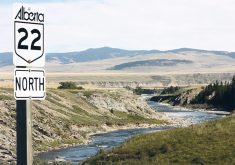CHICAGO, Ill. — The downturn in the American farm economy will continue for a while, says a U.S. banker.
“This is not going to be over at the end of 2017,” Curt Hudnutt, chief commercial officer of Rabo Agrifinance, told delegates attending the 2016 DTN Ag Summit.
Rabo sees worsening losses next year in corn and soybean producing states. By 2018, half of American growers will break even and the other half will lose money.
Profitability will return to the farm sector in 2019 because of declining costs, in particular falling land rent. Rental rates are always slow to respond to a slumping farm economy.
Read Also

New coal mine proposal met with old concerns
A smaller version of the previously rejected Grassy Mountain coal mine project in Crowsnest Pass is back on the table, and the Livingstone Landowners Group continues to voice concerns about the environmental risks.
American farm incomes are being hit by the strong U.S. dollar that limits exports, while producers in countries with weaker currencies enjoy stronger exports and more attractive farmgate prices.
Hudnutt said American farmland values have dropped by 10 to 12 percent the last couple of years and will likely tumble another 10 to 12 percent in the next two years.
“So you’re looking at about a 20 to 25 percent total downturn,” he said.
The value of good quality land is down only five to six percent. Discounts are steeper on marginal land.
It also varies by state. Iowa is seeing the biggest declines in farmland value because it experienced the largest appreciation before the downturn.
Hudnutt said this is all part of the normal cyclical nature of agriculture. The good news is the problem is related to excess supply rather than slumping demand.
“This is not Armageddon. This is not 1985 again,” he said, referring to the period when farm bankruptcies were a major problem.
Farmers are in better shape to weather the storm this time around.
They own fewer acres and rent more than they did in 1985, and that helps protect their balance sheets. They also have plenty of net worth and working capital.
In the 1980s, almost none of the long-term debt held by farmers was at a fixed rate. Today 75 percent is fixed, which shields that debt against the threat of rising interest rates.
Interest rates are low compared to the 1980s. Hudnutt encouraged farmers to switch any variable rate debt they have to a fixed rate because he believes American interest rates will rise under a Donald Trump presidency.
Growers can also expect more price volatility with a Trump government, but that’s not necessarily a bad thing.
“In low commodity price times, volatility is actually our friend.”
Hudnutt warned growers not to count on subsidies to save their farms. The 2014 farm bill got it backward, he said. It doled out the Agriculture Risk Coverage (ARC) payments when farmers were doing well and now there is nothing left in the program when they really need it.
One of the things he would like to see in the 2018 farm bill is a bolstered Conservation Reserve Program because farmers need to take three to six million acres out of production, and that isn’t going to happen under the existing CRP.
The only way the farm economy can return to profitability by 2019 is if those acres come out of production, forcing grain prices higher.
One factor that can change the entire outlook is the weather, but Hudnutt said a drought in the U.S. would be the worst thing that could happen.
“It will make it worse and it will make it longer because we won’t take the actions we need to take,” he said.
Those actions include renegotiating rental rates with landlords and being prepared to walk away from marginal acres if the landlord is unwilling to budge.
Farmers should consider selling excess equipment and using what remains better. Do they really need two combines when one could do the job?
They need to think about liquidating non-core assets such as cabins and airplanes.
Growers should partner with niche and emerging food companies and consider growing unconventional crops such as edible beans, where there can be big premiums.
Hudnutt said they should hire professionals to assist them with managing their finances and steer clear of taking advice from yes-men or fellow farmers on coffee row.
“Avoid group think. You don’t want to surround yourself necessarily with those like-minded folks,” he said.
He also advised farmers to talk to their lenders early and often because bankers see lots of producers and know what works and what doesn’t.
If they are not helpful, it is time to find a different lender, he added.


















